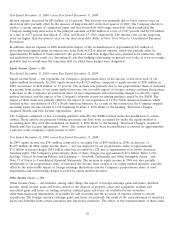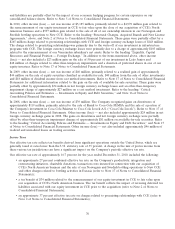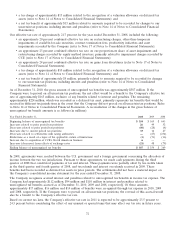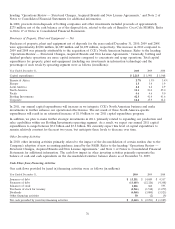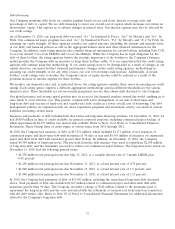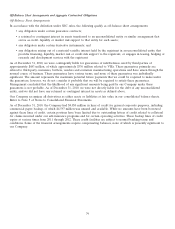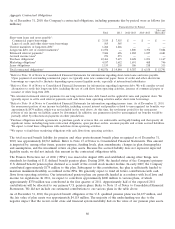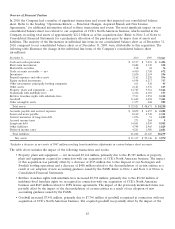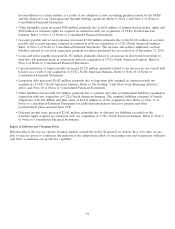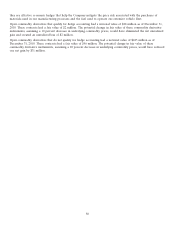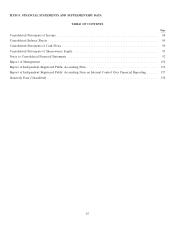Coca Cola 2010 Annual Report Download - page 79
Download and view the complete annual report
Please find page 79 of the 2010 Coca Cola annual report below. You can navigate through the pages in the report by either clicking on the pages listed below, or by using the keyword search tool below to find specific information within the annual report.Debt Financing
Our Company maintains debt levels we consider prudent based on our cash flows, interest coverage ratio and
percentage of debt to capital. We use debt financing to lower our overall cost of capital, which increases our return on
shareowners’ equity. This exposes us to adverse changes in interest rates. Our interest expense may also be affected by
our credit ratings.
As of December 31, 2010, our long-term debt was rated ‘‘A+’’ by Standard & Poor’s, ‘‘Aa3’’ by Moody’s and ‘‘A+’’ by
Fitch. Our commercial paper program was rated ‘‘A-1’’ by Standard & Poor’s, ‘‘P-1’’ by Moody’s and ‘‘F-1’’ by Fitch. In
assessing our credit strength, all three agencies consider our capital structure (including the amount and maturity dates
of our debt) and financial policies as well as the aggregated balance sheet and other financial information for the
Company. In addition, some rating agencies also consider financial information for certain bottlers, including New CCE,
Coca-Cola Amatil, Coca-Cola FEMSA and Coca-Cola Hellenic. While the Company has no legal obligation for the
debt of these bottlers, the rating agencies believe the strategic importance of the bottlers to the Company’s business
model provides the Company with an incentive to keep these bottlers viable. It is our expectation that the credit rating
agencies will continue using this methodology. If our credit ratings were to be downgraded as a result of changes in our
capital structure, our major bottlers’ financial performance, changes in the credit rating agencies’ methodology in
assessing our credit strength, or for any other reason, our cost of borrowing could increase. Additionally, if certain
bottlers’ credit ratings were to decline, the Company’s share of equity income could be reduced as a result of the
potential increase in interest expense for these bottlers.
We monitor our financial ratios and, as indicated above, the rating agencies consider these ratios in assessing our credit
ratings. Each rating agency employs a different aggregation methodology and has different thresholds for the various
financial ratios. These thresholds are not necessarily permanent, nor are they always fully disclosed to our Company.
Our global presence and strong capital position give us access to key financial markets around the world, enabling us to
raise funds at a low effective cost. This posture, coupled with active management of our mix of short-term and
long-term debt and our mix of fixed-rate and variable-rate debt, results in a lower overall cost of borrowing. Our debt
management policies, in conjunction with our share repurchase programs and investment activity, can result in current
liabilities exceeding current assets.
Issuances and payments of debt included both short-term and long-term financing activities. On December 31, 2010, we
had $4,850 million in lines of credit available for general corporate purposes, including commercial paper backup, of
which approximately $4,597 million was unused and available. Refer to Note 10 of Notes to Consolidated Financial
Statements. These backup lines of credit expire at various times from 2011 through 2012.
In 2010, the Company had issuances of debt of $15,251 million, which included $1,171 million of net issuances of
commercial paper and short-term debt with maturities of 90 days or less and $9,503 million of issuances of commercial
paper and short-term debt with maturities greater than 90 days. In addition, on November 15, 2010, the Company
issued $4,500 million of long-term notes. The proceeds from the debt issuance were used to repurchase $2,910 million
of long-term debt, and the remainder was used to reduce our commercial paper balance. The long-term notes issued on
November 15, 2010, had the following general terms:
• $1,250 million total principal notes due May 15, 2012, at a variable interest rate of 3 month LIBOR plus
0.05 percent;
• $1,250 million total principal notes due November 15, 2013, at a fixed interest rate of 0.75 percent;
• $1,000 million total principal notes due November 15, 2015, at a fixed interest rate of 1.5 percent; and
• $1,000 million total principal notes due November 15, 2020, at a fixed interest rate of 3.15 percent.
In 2010, the Company had payments of debt of $13,403 million, including the repurchased long-term debt discussed
above. Total payments of debt also included $9,667 million related to commercial paper and short-term debt with
maturities greater than 90 days. The Company recorded a charge of $342 million related to the premiums paid to
repurchase the long-term debt and the costs associated with the settlement of treasury rate locks issued in connection
with the debt tender offer. Refer to Note 10 of Notes to Consolidated Financial Statements for additional information
related to the Company’s long-term debt.
77




